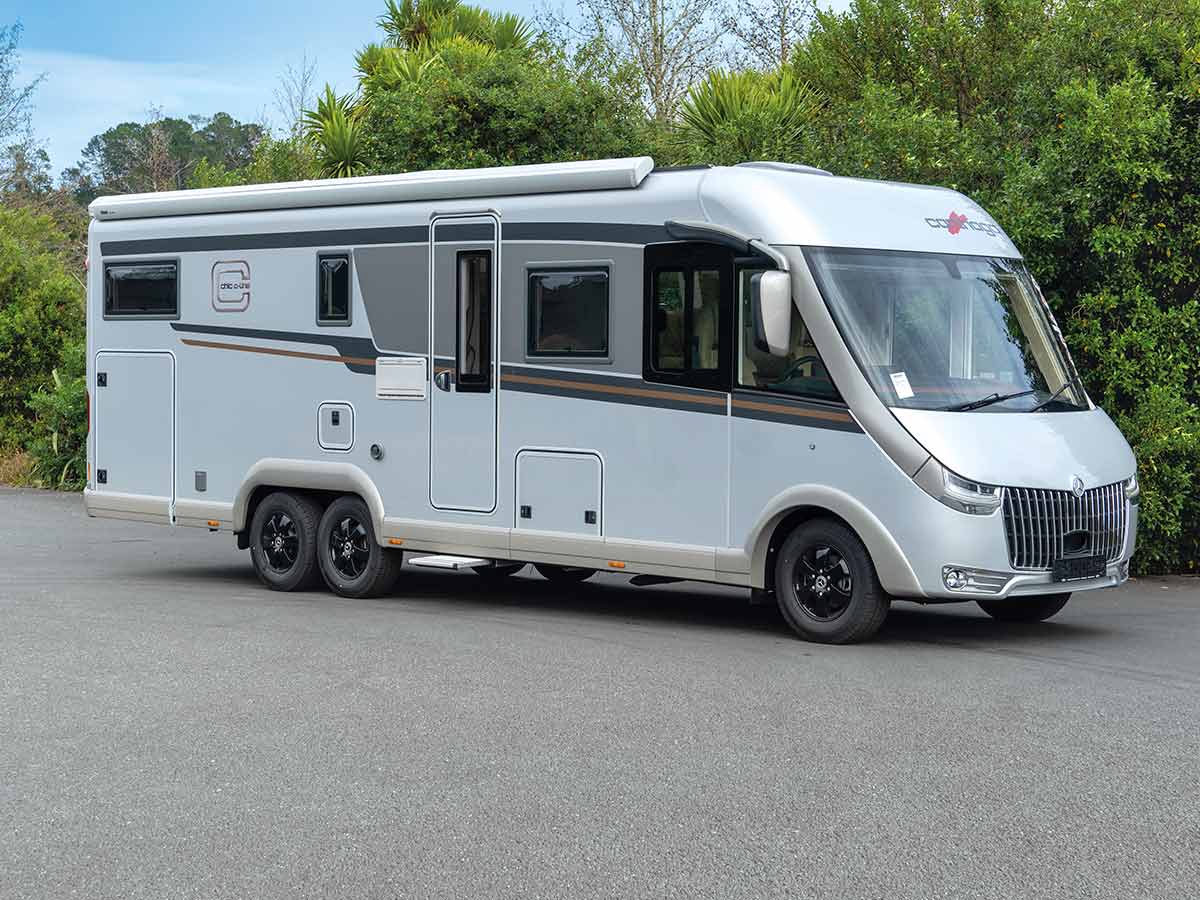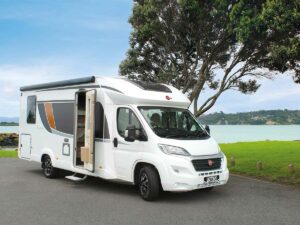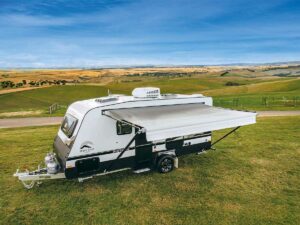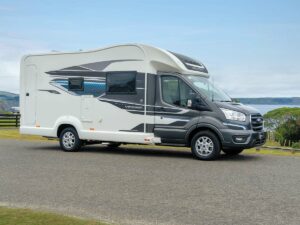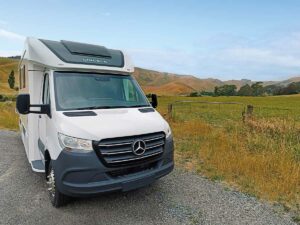Luxury motorhomes are certainly in a class (an A-Class) of their own, but even at this elite level, not all are created equal. Paul Owen spends some time with the Carthago C-Line 5.9 and discovers that the European reputation for excellence is well deserved.
It may come as a surprise to learn that some A-Class motorhomes are better than others. It’s easy to assume that the high prices asked for these fully-integrated motorhomes (where manufacturers assume all responsibilities for the design and construction of the spacious bodies) buys a top-shelf segment of the RV market that represents the ultimate in recreational touring luxury. So surely, these elite vehicles will all be beyond reproach.
Given the high purchase price, an A-Class should inhabit the motorhome A-list when it comes to refinement, design, construction, and execution. However, some A-Class RVs can disappoint when presented with some simple everyday tasks.
You might turn on the windscreen wipers for the first time and find that the sweep of the blades fails to entirely clear the driver’s view of the road ahead. Then, when the windscreen washing fluid runs out, you might find that the filler cap is tucked so far behind the extended front grille and dashboard that only a contortionist with arms seemingly made of rubber can reach it. Ditto the access to the oil cap should the motor need a top-up of this essential life-sustaining fluid. Then, if driver error causes an unexpected contact between the rear GRP panel of the A-Class body and a post, you may find that the repair requires that expensive panel to be replaced in its entirety, increasing the time that the motorhome will sit gathering dust in the approved repair shop’s yard. Large GRP parts like this often need to be shipped from Europe, as they’re too big to squeeze into the freight bays of ordinary aircraft.
I’m happy to report that none of the above applies to this sumptuous Carthago Chic C-Line I 5.9 XL LE. For, like all Carthagos, the creation of the new body, and the adaption of a sliced-off Mercedes-Benz Sprinter van platform, include fitting the longer wipers to totally clear the view through the much-enlarged windscreen. The essential fluid refilling lines have also been extended forwards so that they’re readily at hand as soon as you lift the huge gas-strut equipped bonnet. There’s also a separate rear bumper beneath the rear panel, ready to sacrifice itself in encounters with seemingly suicidal fence posts, leaving the humungous GRP panel above it unscathed.
In more ways than those that are readily apparent during the initial buying process, Carthago has sorted out all the finer details of building the best A-Class models that it can, using the experience gleaned over decades of perfecting the design and the process. The first A-Class Carthago, the Chic T, made its debut at the 2003 Dusseldorf Caravan Exhibition exactly 20 years ago.
Fiat or Mercedes?
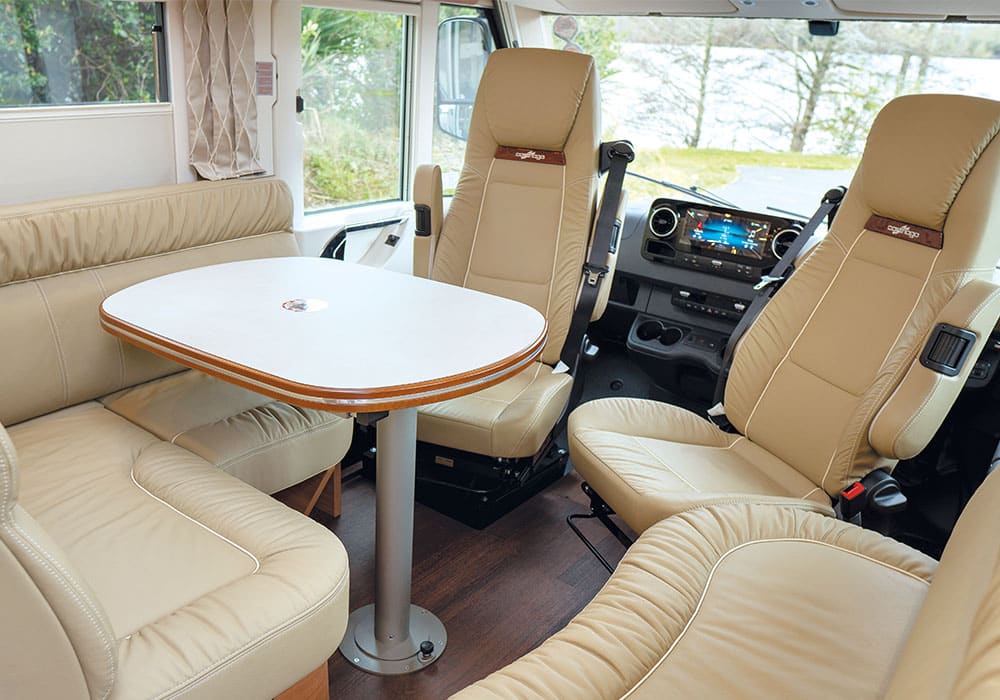
Carthago emerged from its humble beginnings as a low-volume converter of air-cooled Volkswagen T4 vans into desirable campers in the 1970s to become an aspirational luxury motorhome brand by the turn of the century. These days, the preferred starting points for the brand are the Fiat Ducato, Iveco Daily, and the Mercedes Sprinter. Although a leviathan by the expectations of the New Zealand market, the I 5.9 XL LE is the shorter of the two six-wheel models in the Chic C-Line range. It extends 8.53 metres in length, 250mm shorter than the Big Daddy of them all, the I 6.2 XL QB, which offers a queen-sized island bed and a couple of extra wardrobes at the rear instead of the convertible twin singles of the LE.
Both six-wheelers can be ordered on either the Ducato or the Sprinter platform, and Jonas Ng, owner of the New Zealand Carthago distributor, Zion Motorhomes, says that the Fiat version usually costs between $20,000 and $25,000 less than the Mercedes option. That’s a premium that’s likely to be recouped at resale time given the market perceptions of both automotive brands. Both front-drive powertrains come with superb nine-speed automatic gearboxes, and AdBlue urea injection to achieve far-healthier-for-everyone Euro 6 emission control.
They also can be ordered with added driver assistance and infotainment features, with the 180bhp Fiat able to be upgraded to a 10.1-inch touchscreen to match the glorious 10.2-inch MBUX screen of the Merc. The 170bhp Sprinter version can be specified with an added radar to assist the cruise control to maintain following distances to the vehicle in front, and the mounting recess in the middle of the grille looks incomplete without it. This radar will also automatically trigger plenty of emergency braking G-force whenever it detects that a collision is imminent.
A discreet spy camera can also be fitted to monitor driver alertness and will give a warning if it senses that the person at the steering wheel is about to slouch off to the Land of Nod. These three active safety additions are all bundled into one package, and if just one of them prevents an incident from occurring during the ownership of the I 5.9 XL LE, then the money for that package has been well-spent.
Both powertrains, their attendant electronic architecture, the HVAC systems, and the running gear of the source vans get mounted on AL-KO’s heavy-duty chassis. Featuring the chassis-maker’s well-sorted twin trailing-arm suspension at the rear, matched with wider-tracked AL-KO front suspension to take full advantage of the extra cab space of an A-Class body, it’s a highly robust structure that ups the maximum permissible vehicle mass to 5500kg – a significant improvement on the 4500kg Gross Vehicle Mass (GVM) limit of the Mercedes CDI 417 donor van.
With a maximum payload of 1100kg, I 5.9 XL LE owners can take full advantage of the large rear garage (350kg load limit) and indulge in the many electronic upgrades that Carthago offers, which fit extra solar panels, larger capacity inverters, and increase battery storage. Such is the leeway that the payload gives. You don’t have to be too wary of using the 1600kg towing capacity to the full either or indulging in Carthago’s mass-adding air suspension option that will level the C-Line at the push of a button.
Onto this platform, Carthago carefully adds the assembled components of its complete wood-free body. The double floors are spaced 220mm apart to mount the water tanks, with the Alde central heating unit in between. Side and rear walls are double insulated and cloaked with aluminium sheet on the interior and exterior sides. Aluminium frame members secure the walls to the floor and to the roof, with ultra-strong adhesives bonding the body parts together along the entire length of the Carthago. Insulation is at least 38mm thick in every section of the body.
A signature of the design is the way the side walls curve inwards at the top to meet the GRP roof, with joining rails guttered to deflect rainwater (there’s a 10-year guarantee against water ingress). Along with the equally well-integrated front mask, the lack of any visible roof-to-wall joints gives the Carthago a sleekness lacking in more ordinary motorhomes.
Drives like a car
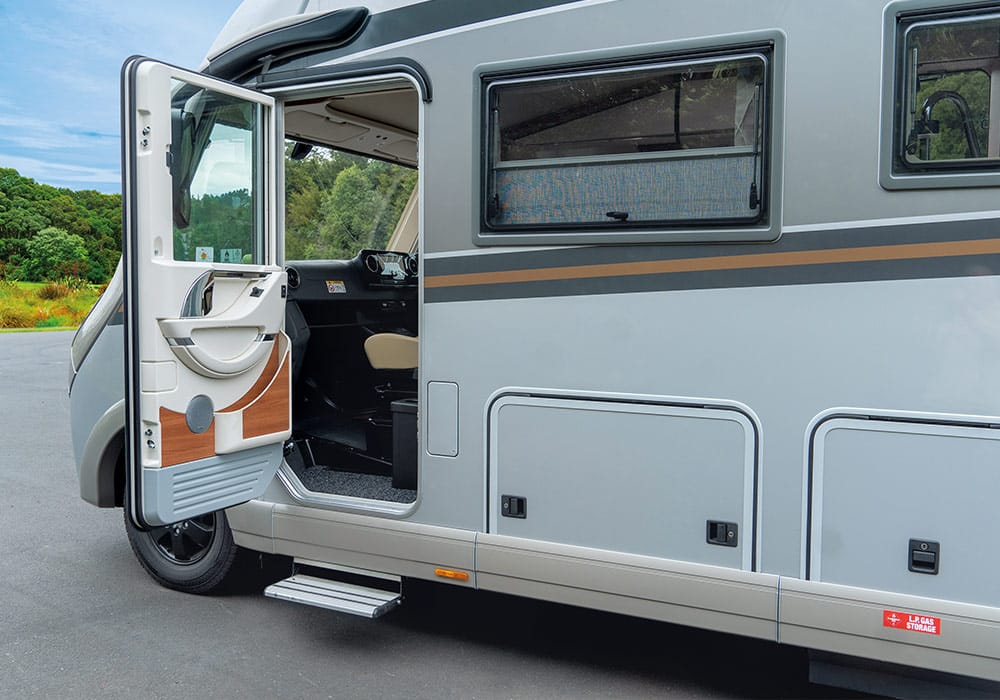
Although the I 5.9 XL LE is bus-like in its wheel count, shape, and dimensions, the driving experience will be instantly familiar to anyone who’s driven a Mercedes passenger vehicle. The Carthago rides with premium vehicle decorum, even when traversing our rougher back roads; the supple AL-KO suspension blotting out any surface imperfections without any deviation from the driver’s chosen driving line.
The steering is light and surprisingly agile for a vehicle almost nine metres in length, and the optional Dometic Waeco twin-lens reversing camera has one view that acts as a centrally placed rear-view mirror while driving and automatically switches over to the other more close-up display of what’s immediately behind the vehicle when reverse gear is selected.
The Mercedes 2.2-litre turbodiesel has enough grunt to shift the 4000kg unladen mass of the 5.9 XL with ease, and the gearbox software is always on the case when it comes to proper ratio selection and exemplary shift quality. Both qualities bode well for the recording of low fuel consumption numbers when touring in the six-wheeler.
Inner space
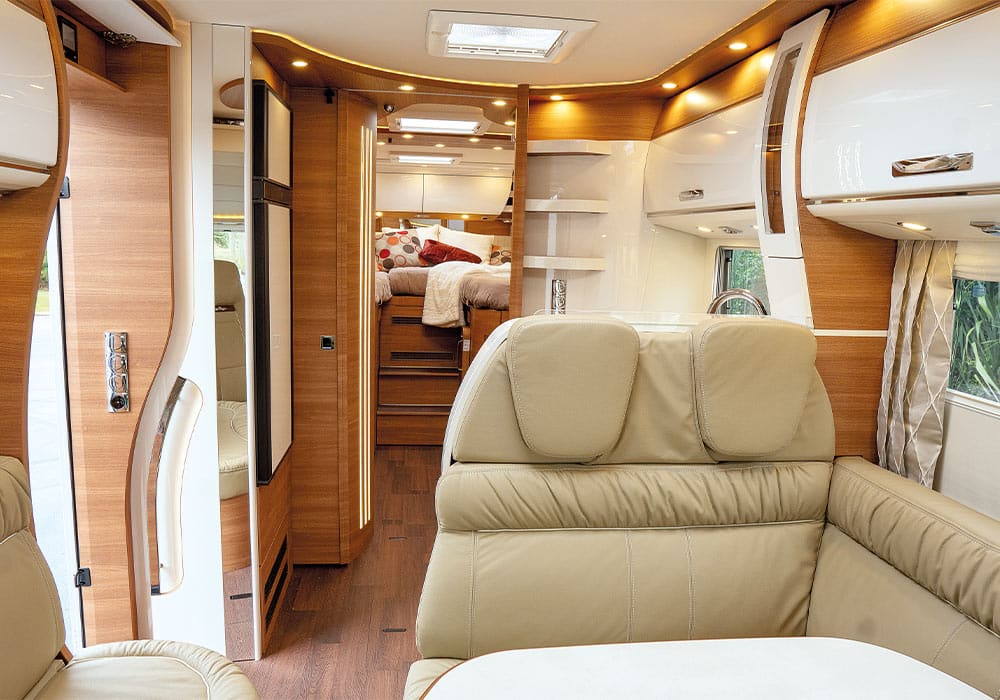
The 5.9 XL LE version of the Chic C-Line range is 110mm longer than the I 4.9 LE L four-wheeled model reviewed recently, and most of that extra length is devoted to the washroom/toilet/shower area located between the kitchen and the rear bedroom. The result is a personal grooming space that’s wonderfully user-friendly and offers less compromise than the bathrooms fitted to many motorhomes. The impression of space is amplified by the many mirrors fitted. Close the sliding doors at either end and you’re offered views of yourself from just about every side. Narcissists will appreciate all the attention.
The toilet area has one of the radiators heated by the Alde heating and hot water system, which both keep the middle of the motorhome warm, while drying out any damp towels. Once again, there’s plenty of space available when you close off the toilet area completely with its side door, and personal business can be conducted in there without any need to tuck your legs up uncomfortably. Next door is a huge floor-to-ceiling wardrobe, allowing easy access to clothes after a shower in the cylindrical chamber on the other side, which is accompanied by a washing area featuring a square basin, U-turning tap, and large set of drawers. Here, the mirror lighting is of the sort found in theatrical dressing rooms. It’s, therefore, easy to feel like a star when preening yourself in the Carthago.
The kitchen and front lounge are no less spacious, nor is the drop-down double bed above the latter, which comes down far enough to enable plenty of sit-up-in-bed headspace. That’s once you’ve made room for the drop by folding the backs of the front seats almost completely down. Prospective buyers should consider carefully whether they really need that extra double bed, for the alternative is extra front lounge headroom and increased natural light entering the cabin via an added skylight. Dropping the pull-down bed when ordering is the ticket to making the I 5.9 XL LE feel even more spacious than it already is.
What does it cost?
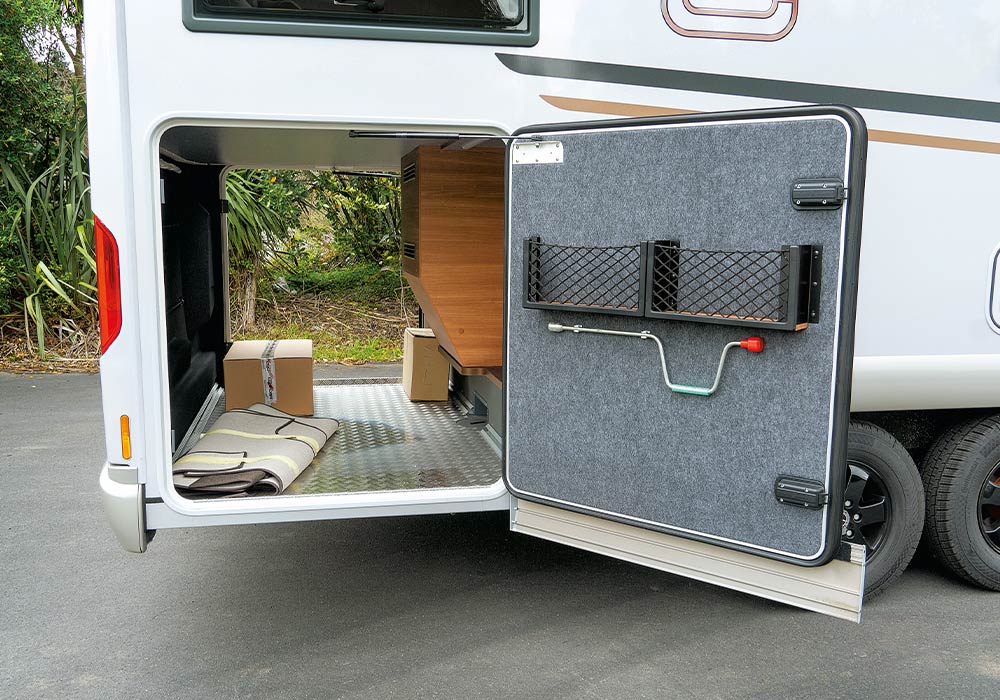
The burning question. Such are the number of options available, it was hard to get a quick answer, as coming up with the correct number will require a complete equipment audit and use of a calculator. By the time this magazine goes to print, Jonas has promised that that number will be logged into the specification table adjacent to this. If the number starts with a ‘4’ it won’t come as any surprise to me, for every aspect of the Carthago Chic C-Line I 5.9 XL LE easily justifies such expenditure.
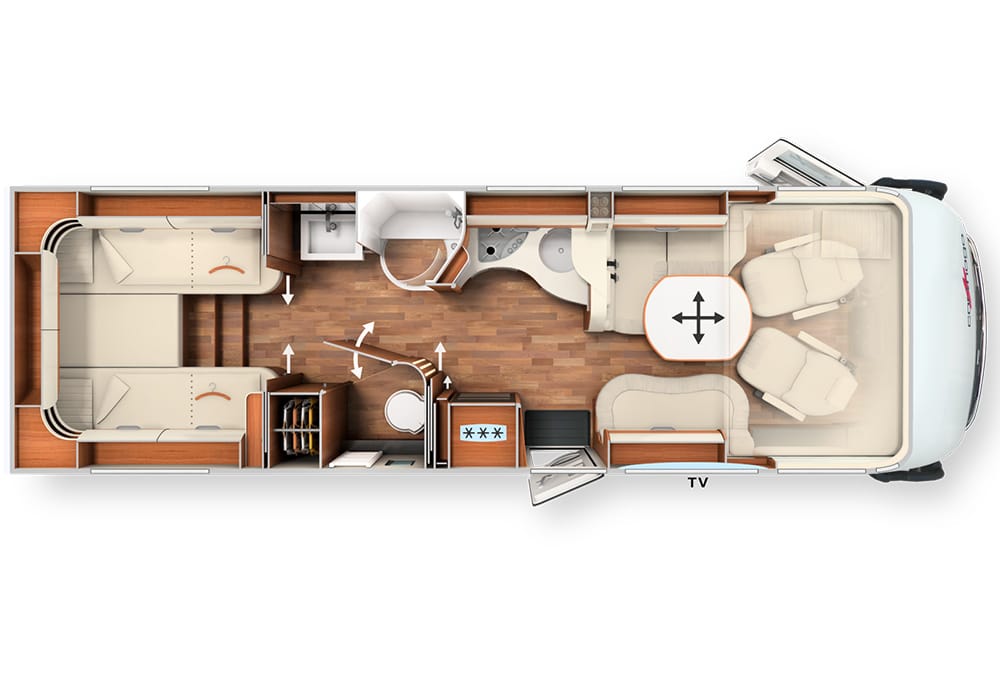
| Make & model | Carthago Chic C-Line I 5.9 XL LE |
|---|---|
| Chassis | Mercedes Sprinter/AL-KO chassis, front wheel drive |
| Engine | 2.2L turbo diesel, 170bhp |
| Gearbox | Nine-speed automatic |
| Berths | 4–5 (need to pre-order) |
| Length/width/height | 8530mm/2270mm/2945mm |
| Fresh/Grey water | Fresh 170L /Grey 140L |
| Unladed mass (tare) | 3800kg |
| GVW/PAYLOAD | 5500kg/1100kg |
| Price | $415,000 |

